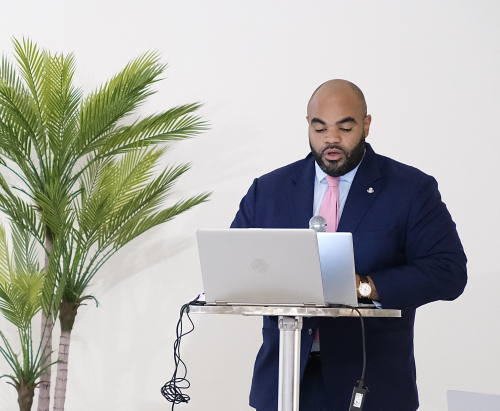 PHILIPSBURG:--- Minister of VROMI, Patrice Gumbs Jr in response to questions posed about the cost of the Sargassum clean up and concerning environmental management and financial stewardship of critical government projects.
PHILIPSBURG:--- Minister of VROMI, Patrice Gumbs Jr in response to questions posed about the cost of the Sargassum clean up and concerning environmental management and financial stewardship of critical government projects.
The Ongoing Battle with Sargassum
Sargassum—a pervasive seaweed that affects many Caribbean countries, including St. Maarten —poses significant environmental and economic challenges. The cleanup process, although essential in maintaining the island’s ecological balance and upholding tourism standards, comes with hefty costs and logistical hurdles.
When asked about the financial impact of these efforts, Minister Gumbs Jr. admitted that specific figures were not immediately available but assured the public that his team would provide those details soon. “The costs associated with Sargassum cleanup are considerable, and we recognize that addressing this issue is an ongoing commitment for the government,” he acknowledged.
The Minister also emphasized that the government’s responsibility extends beyond merely clearing the visible seaweed. Effective and sustainable solutions are necessary to mitigate the long-term environmental, health, and economic impacts of Sargassum.
Financial Oversight of Government Projects
Minister Gumbs Jr. provided insights into how the government manages its funds for large-scale environmental and infrastructural projects, including Sargassum management and trust-funded programs. He emphasized that all travel and operational expenses associated with these projects are funded through the national budget, rather than by external agencies such as the NRPB or the World Bank, even when those institutions are involved in the implementation process.
“The projects are ultimately ours; they are the government of St. Maarten’s projects. We must take ownership, whether the outcome is good or bad,” reiterated the Minister. This transparent and accountable approach reflects the administration’s commitment to ensuring public funds are utilized effectively.
The Realities of Cost Management
With significant portions of the national budget allocated to operational expenditures for large-scale infrastructure and environmental programs, the government faces a challenging balancing act. Minister Gumbs Jr. revealed that travel associated with these projects is a necessary expense, tied directly to ensuring the successful execution of strategic plans.
Such costs, the Minister explained, accompany the government’s broader effort to uphold its operational responsibilities. “NRPB’s budget covers their operational costs, but trust-funded projects must be financed through the government’s national budget. That’s how these processes work,” Gumbs Jr. clarified.
Ongoing Challenges and Next Steps
Despite progress in addressing issues such as Sargassum and infrastructure improvements, challenges persist in securing sufficient financial resources and managing project timelines. The Minister assured citizens that his team is working diligently to address these hurdles while maintaining a focus on transparency and accountability.
To support broader government initiatives, Minister Gumbs Jr. emphasized the need for a more integrated and holistic approach, highlighting the importance of collaboration among various stakeholders. Long-term success depends not only on current efforts but also on proactive planning and community engagement.
Looking Ahead
The updates from Minister Patrice Gumbs Jr. highlighted the complexities involved in managing environmental crises, such as Sargassum, while balancing public funds for crucial projects. The administration’s approach—anchored in transparency, accountability, and sustainable development—signals a commitment to improving the quality of life for St. Martin residents.
Continuing the fight against Sargassum and advancing key projects will require strong leadership and community support. These efforts pave the way for a more resilient and sustainable St. Martin, ensuring environmental preservation and fiscal responsibility go hand in hand.